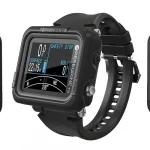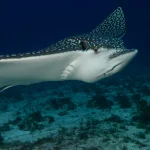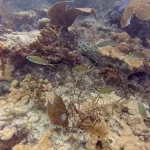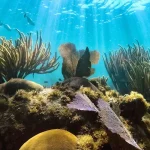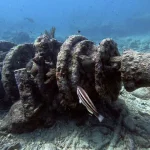Table of Contents
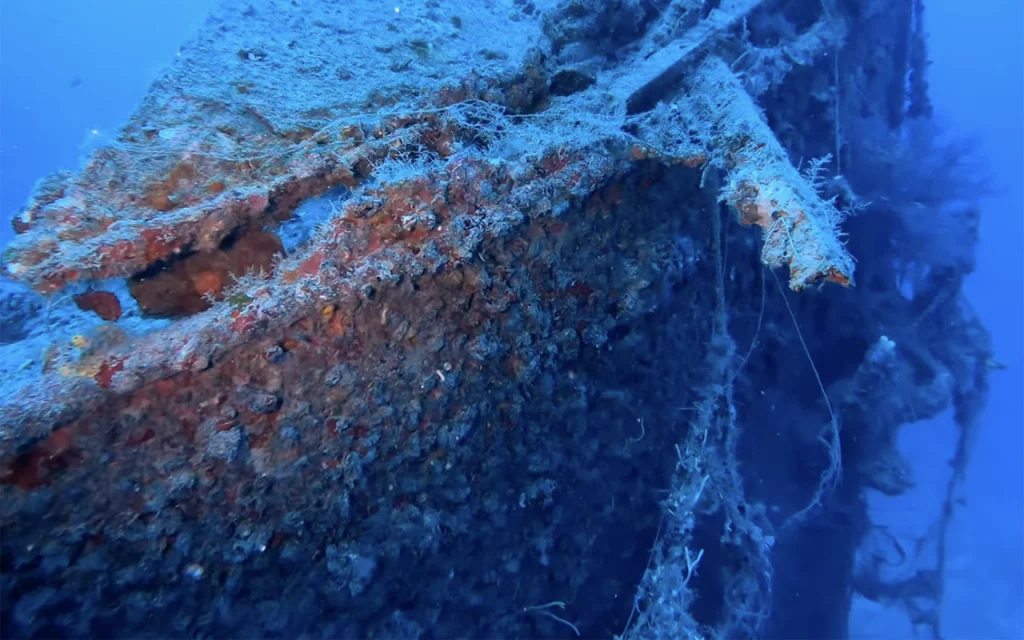
Today, the Northern Light wreck is a popular dive site known for its unique structure and rich marine life. The bow of the wreck is upright, with an anchor hanging on the starboard side, while the stern is inverted. The wreck rests at depths ranging from 150 to 190 feet, making it suitable for intermediate to advanced divers. The site is characterized by exceptional visibility and is home to various marine species, including sharks and colorful fish, providing a vibrant underwater experience for divers exploring its remains.
Article at a Glance
- Historical Significance: The Northern Light wreck, originally built in 1888 as a steel-hulled freighter, has a rich history that includes attempts at insurance fraud and its eventual sinking in 1930 during a storm.
- Unique Structure: The wreck features an upright bow with an anchor still attached, while the stern lies upside down, creating a distinctive diving experience with various exploration opportunities.
- Diverse Marine Life: The site is home to a variety of marine species, including bull sharks, nurse sharks, snapper, grouper, and rays, making it a vibrant underwater ecosystem.
- Diving Conditions: Located at depths of 150 to 190 feet (approximately 45 to 58 meters), the wreck offers excellent visibility, often ranging from 30 to 45 meters (100 to 150 feet), ideal for experienced divers.
- Safety Measures: Dive operators implement strict safety protocols, including certification requirements, guided dives, equipment checks, and emergency procedures to ensure diver safety.
- Identifiable Features: Notable historical features of the wreck include the rudder, a toilet against the bulkhead, and various anchors left by previous divers, enhancing the exploration experience.
- Dive Shops: Several dive shops in Key Largo offer trips to the Northern Light wreck, including Sea Dwellers Dive Center, Paradise Island Charters, Key Dives, Conch Republic Divers, and Rainbow Reef Dive Center, catering to different skill levels and preferences.
Northern Light Wreck Location Coordinates and Depth
Depth
The wreck lies at a depth of approximately 58 meters (or 190 feet) off Elbow Reef near Key Largo in the Florida Keys, Florida, USA.
Location Coordinates
The Northern Light wreck is located at the following coordinates:
- GPS Coordinates: 25° 05.040′ N, 80° 21.643′ W
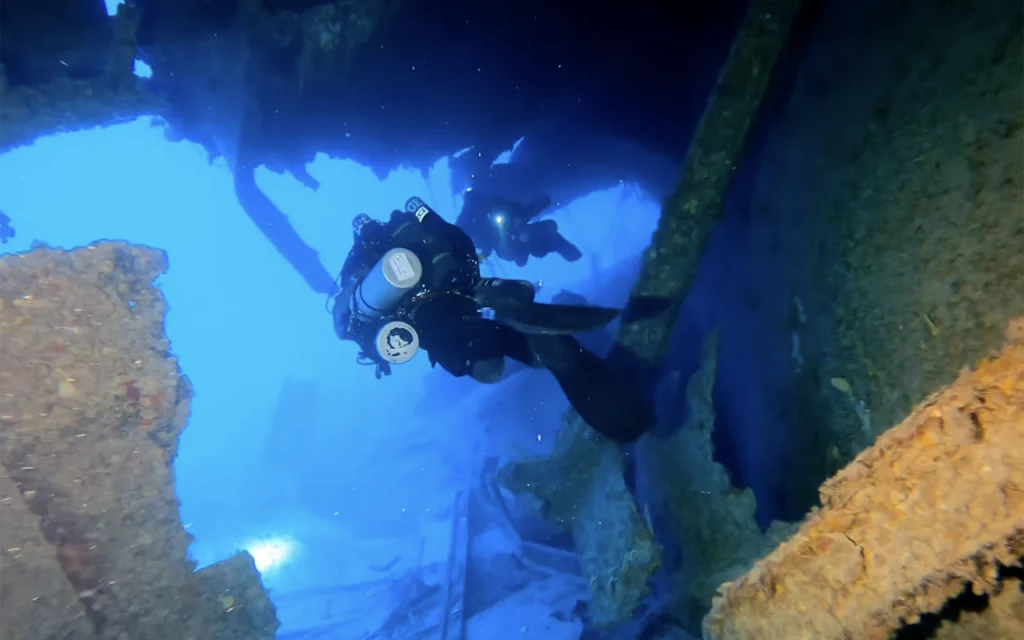
What to Scuba Divers Say About This Wreck
- Diving Experience: The Northern Light wreck is considered an excellent dive site for intermediate to advanced divers. The wreck lies at a depth of approximately 58 meters (190 feet) and offers exceptional visibility ranging from 30 to 45 meters (100 to 150 feet) .
- Wreck Structure: Divers note the distinct orientation of the wreck, with the bow upright and the stern upside down. The wreck features an anchor hanging on the starboard side and a rudder turned hard to starboard located about 44 meters (145 feet) deep. The wreck also contains remnants like a toilet against the bulkhead, which adds to its intriguing exploration opportunities .
- Marine Life: The site is rich in marine biodiversity, with sightings of bull and nurse sharks, snapper, grouper, pompano, barracuda, and rays. This vibrant marine life enhances the diving experience, making it not only a wreck dive but also a chance to observe various species .
- Historical Context: The wreck has an unusual history, having been originally a Great Lakes freighter before being converted into a barge. It sank during a storm in 1930, and divers often reflect on the ship’s storied past while exploring its remains .
What Kind of Marine Life Can Be Found on The Wreck
- Bull Sharks: These large sharks are often spotted in the vicinity, adding an element of excitement to the dive.
- Nurse Sharks: Typically more docile, nurse sharks can also be seen resting on the seafloor near the wreck.
- Snapper: Various species of snapper inhabit the area, contributing to the vibrant underwater ecosystem.
- Grouper: These fish are commonly found around the wreck, often hiding in crevices.
- Pompano: Known for their speed and agility, pompano can be observed swimming in the open water.
- Barracuda: These predatory fish are frequently seen patrolling the waters around the wreck.
- Rays: Different species of rays can also be spotted, gliding gracefully along the sandy bottom.
Key Information
| Key Information | Details |
|---|---|
| Location | Elbow Reef, Florida Keys |
| Coordinates | 25° 05.040′ N, 80° 21.643′ W |
| Depth | Approximately 58 meters (190 feet) |
| Year Sunk | 1930 |
| Original Use | Great Lakes freighter, later converted to a barge |
| Notable Features | Upright bow with anchor, upside-down stern, rudder turned hard to starboard, remnants of a toilet |
| Marine Life | Bull sharks, nurse sharks, snapper, grouper, rays |
| Diving Experience Level | Intermediate to advanced divers |
| Visibility | 30 to 45 meters (100 to 150 feet) |
| Dive Shop Recommendations | Various dive shops in Key Largo offer trips |
What Makes Northern Light a Unique Diving Experience
- Historical Significance: Built in 1888, the Northern Light was one of the first steel-hulled steam freighters. Its journey from the Great Lakes to becoming a barge and ultimately sinking in a storm adds a layer of intrigue to the dive. The wreck’s history includes an attempted insurance scam that led to its burning and subsequent modifications, making it a fascinating subject for exploration .
- Wreck Structure: The wreck is notable for its unusual orientation; the bow is upright with an anchor hanging on the starboard side, while the stern is upside down on top of the midship. This unique arrangement allows divers to explore different aspects of the wreck, including large openings that provide access for entry and exploration .
- Diving Conditions: The wreck is located at a depth of 58 meters (190 feet) with exceptional visibility, often ranging from 30 to 45 meters (100 to 150 feet). These clear waters enhance the overall diving experience, allowing divers to appreciate the wreck’s structure and the surrounding marine life .
- Rich Marine Life: Divers can encounter a variety of marine species, including bull and nurse sharks, snapper, grouper, pompano, barracuda, and rays. This diversity adds excitement and beauty to the dive, making it not just a wreck exploration but also a vibrant underwater adventure .
- Exploration Opportunities: The wreck provides ample opportunities for divers to fin around and inspect its nooks and crannies. The presence of numerous anchors left by fishing trips and wreck divers adds to the exploration experience, making it a dynamic site for both photography and underwater exploration .
What is The Full History of This Wreck
Construction and Early Years
- Built in 1888: The Northern Light was one of the first steel-hulled steam freighters, originally designed for service on the Great Lakes. It measured 300 feet in length and had a beam of 40 feet, making it a significant vessel for its time.
Transition to Ocean Use
- Ownership Changes: After several ownership changes, in 1917, the vessel’s owner attempted to convert it into an ocean-going vessel. However, due to its size, it was unable to pass through the locks of the Great Lakes system.
- Modification for Transport: To move the ship, the owner resorted to burning out the rivets that held the hull together, causing it to split into two sections. This allowed the ship to be transported through the locks, after which it was reassembled and made seaworthy.
Insurance Fraud Attempt
- Economic Challenges: The Northern Light was later relocated to Mobile, Alabama, but the economic downturn of the 1920s made it financially unviable.
- Arson for Insurance: On August 16, 1927, the owner attempted to commit insurance fraud by setting the ship on fire along with several others. Although the fire caused significant damage, the Northern Light survived and was subsequently sold and converted into a barge.
Final Voyage and Sinking
- Storm and Sinking: On November 8, 1930, while being towed during a severe storm, the Northern Light separated from its tow vessel and sank off Elbow Reef near Key Largo, Florida. The wreck split into two parts during the sinking, with the stern ending up upside down on top of the midsection.
- Tragic Loss of Life: Of the seven crew members aboard at the time, five perished in the storm, and only two survived. The bodies of five of the six deceased were never recovered.
Current State and Diving
Today, the Northern Light wreck is a popular dive site known for its unique structure and rich marine life. The bow of the wreck is upright, with an anchor hanging on the starboard side, while the stern is inverted. The wreck rests at depths ranging from 150 to 190 feet, making it suitable for intermediate to advanced divers.
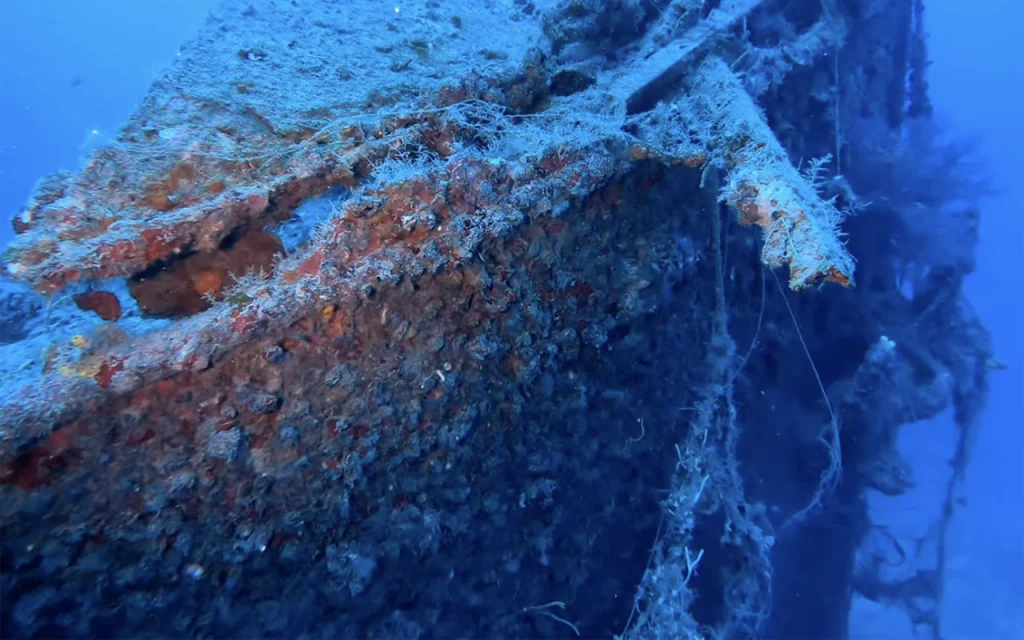
What Historical Features Can Still Be Identified on Wreck
- Upright Bow: The bow of the wreck remains upright, with an anchor still attached to the windlass on the starboard side. This feature allows divers to easily identify the front section of the ship.
- Upside-Down Stern: The stern is positioned upside down on top of the midship section, creating a unique structural formation that divers refer to as the “Elbow Wreck.” This unusual orientation adds character to the site and creates interesting areas for exploration.
- Rudder: The rudder is turned hard to starboard and can be found at approximately 145 feet deep. Its position provides a glimpse into the ship’s operational mechanics before it sank.
- Toilet Against the Bulkhead: A notable feature within the wreck is a toilet that remains against the bulkhead, offering a glimpse into the ship’s interior and the life of the crew.
- Numerous Anchors: Divers often encounter various anchors left behind from fishing trips and previous wreck divers. These anchors contribute to the wreck’s historical narrative and provide additional points of interest for exploration.
- Coral Growth and Marine Life: The wreck is heavily encrusted with marine growth, which has developed over the decades since it sank. This growth not only enhances the visual appeal of the wreck but also supports a diverse marine ecosystem, including species like bull sharks, nurse sharks, and various fish.
What Safety Measures Are in Place for Divers Visiting Northern Light
- Certification Requirements: The Northern Light wreck is classified as an intermediate to advanced dive site. Divers are required to have appropriate certification to ensure they possess the necessary skills and knowledge for deep diving and wreck exploration.
- Guided Dives: Many dive operators in the Key Largo area offer guided dives to the Northern Light wreck. Experienced dive masters lead these excursions, providing safety briefings, ensuring divers are aware of the conditions, and assisting with navigation around the wreck.
- Monitoring Conditions: Dive operators monitor weather and sea conditions closely. The wreck is located in an area that can experience strong currents due to its proximity to the Gulf Stream. Divers are advised to check conditions before diving, and trips may be canceled or rescheduled if conditions are deemed unsafe.
- Dive Equipment Checks: Operators conduct thorough equipment checks before dives to ensure all gear is functioning properly. This includes checking tanks, regulators, buoyancy control devices, and dive computers.
- Emergency Procedures: Dive operators are trained in emergency response procedures. They carry first aid kits and oxygen supplies on board and have protocols in place for dealing with potential dive-related emergencies.
- Dive Briefings: Prior to the dive, divers receive detailed briefings about the wreck, including potential hazards such as fishing lines, sharp objects, and unstable structures. Divers are also informed about the marine life they may encounter, including larger species like sharks.
- Depth Awareness: The wreck lies at depths of 150 to 190 feet (approximately 45 to 58 meters), requiring divers to be aware of their depth limits and manage their air supply accordingly. Dive computers are often used to monitor depth and time to prevent decompression sickness.
Dive Shops That Prove Diving Trips to This Shipwreck
- Sea Dwellers Dive Center of Key Largo
- Rating: 4.8
- Reviews: 668
- Address: 105 Laguna Ave E5, Key Largo, FL 33037
- Website: Sea Dwellers
- Paradise Island Charters
- Rating: 4.9
- Reviews: 127
- Address: 105 Laguna Ave E5, Key Largo, FL 33037
- Website: Paradise Island Charters
- Key Dives
- Rating: 4.7
- Reviews: 215
- Address: 79851 Overseas Hwy, Islamorada, FL 33036
- Website: Key Dives
- Conch Republic Divers
- Rating: 4.9
- Reviews: 202
- Address: 90800 Overseas Hwy Ste 9, Tavernier, FL 33070
- Website: Conch Republic Divers
- Rainbow Reef Dive Center
- Rating: 4.5
- Reviews: 824
- Address: 100 Ocean Dr, Key Largo, FL 33037
- Website: Rainbow Reef

